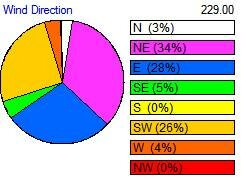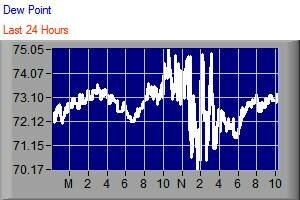Wind, Temperature, Rainfall, and Growing Conditions in Lawrenceville, GeorgiaUpdated at 10:14pm on 7/20/11 Wind Speed and DirectionThe direction and speed of the wind can provide some useful information regarding the weather. In metro Atlanta, the wind is typically out of the west. Because of the influence of the Gulf of Mexico, southwest winds typically bring warmer, more humid air into the area, while northwest winds bring drier, colder air. When winds come from the east, we are typically in an atmospheric condition called Cold Air Damming, or a "wedge", when cold air is trapped beneath warmer, wetter air above. Wind speed can provide useful information during storms to indicate the intensity and speed of a storm. |
|
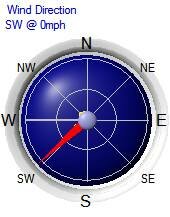 Yellow dots represent the speed and direction of recent wind gusts. The closer the dot is to the outside of the circle, the higher the wind speed.
|
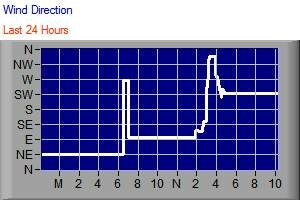
|
|
|
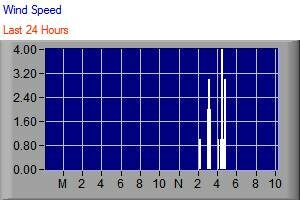 |
Temperature and HumidityWhether we feel cold or warm when we step outside is not just a matter of the current temperature; it also has to do with the humidity and whether the sun is shining. A 90 degree day in humid Atlanta is much less comfortable than in Phoenix, Arizona, where the desert humidity is low. Wind Chill attempts to measure the effects of wind when the weather is cold, and the heat index uses the air temperature and humidity to estimate how the air feels when the air is warm. While both wind chill and heat index provide useful information when it is very warm or very hot, neither measurement is useful during normal, moderate temperatures. The virtual temperature calculation, shown in the left graph, is a calculation that takes moisture into account when estimating the apparent temperature that we feel. The dewpoint, shown in the right graph, is the temperature that, given the amount of water in the air, would need to be reached in order to cause dew or frost to form. It is closely related to relative humidity in that the closer the dewpoint temperature is to the actual temperature, the more humid it is. Weather forecasters sometimes use the dewpoint during the day to estimate the low temperature the following morning -- the midafternoon dewpoint equals the following morning's low. Of course, this is only accurate if the barometric pressure and other factors remain constant throughout the period, which is not always the case. View a table showing the relationship between temperature, humidity, and dew point. |
|
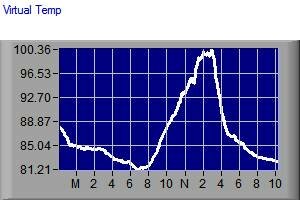 |
|
Rainfall and PrecipitationThese two graphs show the rainfall for the current month, and the total rainfall for the year, as measured at my house in Lawrenceville. The seven day scale of the monthly chart, and the two week scale of the yearly chart provide an indication of the last time it rained. You can look at this page to find information about normal and actual precipitation in Atlanta and Athens. |
|
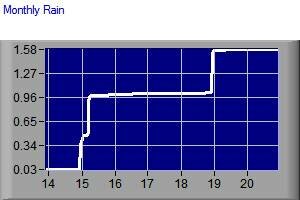 |
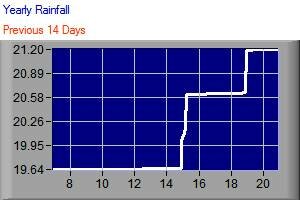 |
Soil Temperature and MoistureSoil temperature and soil moisture are very important for farmers and agricultural interests, since they indicate when crops can be planted, and when irrigation is needed. For example, corn can be planted when the soil temperature rises above 55 degrees, while cotton and alfalfa require the soil temperature to be above 65. Homeowners can use this information to determine when to set out annuals. The graph on the right measures soil moisture on the left axis, and leaf wetness on the right axis. Soil moisture is determined indirectly by measuring the resistance of the soil to electricity, with wetter soils being less resistant to electrical current than try soils. Therefore, a low soil moisture reading means the soil is wet, and a high reading (above 60 or so) means the soil is dry. The leaf wetness reading is just what it says: how much moisture is on the foliage in my yard. It's measured on a scale from 0 to 15, with higher numbers indicating wetter conditions. I decided to combine the two measurements because it's the only way you can get some perspective on how much moisture might be in your yard. When I turn the sprinklers on, it will increase the amount of water in my soil, but obviously, it won't do anything for you. You can compare soil wetness with the last time I watered the yard (measured by leaf wetness) to get some idea of when you might have to get out the sprinklers. |
|
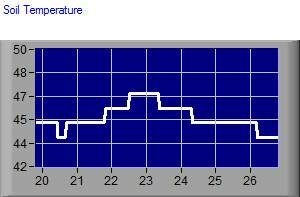 |
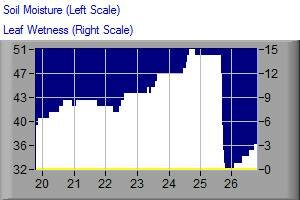 |



